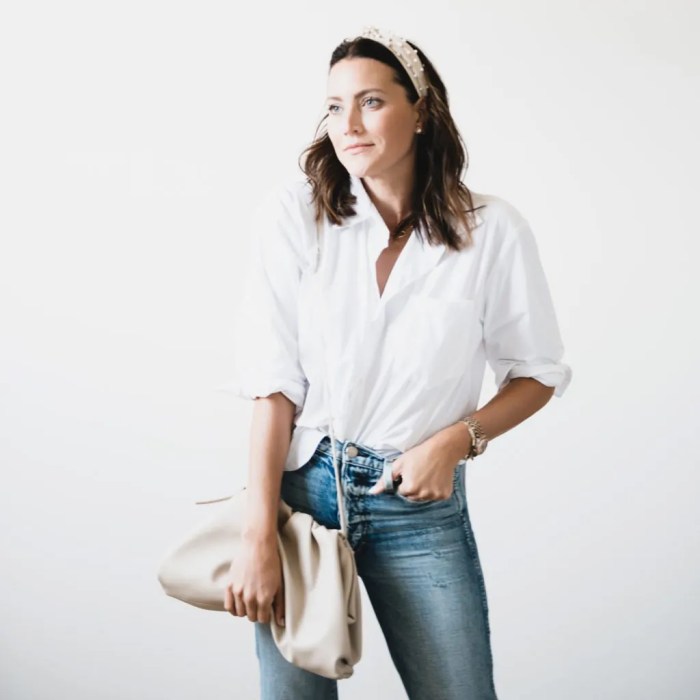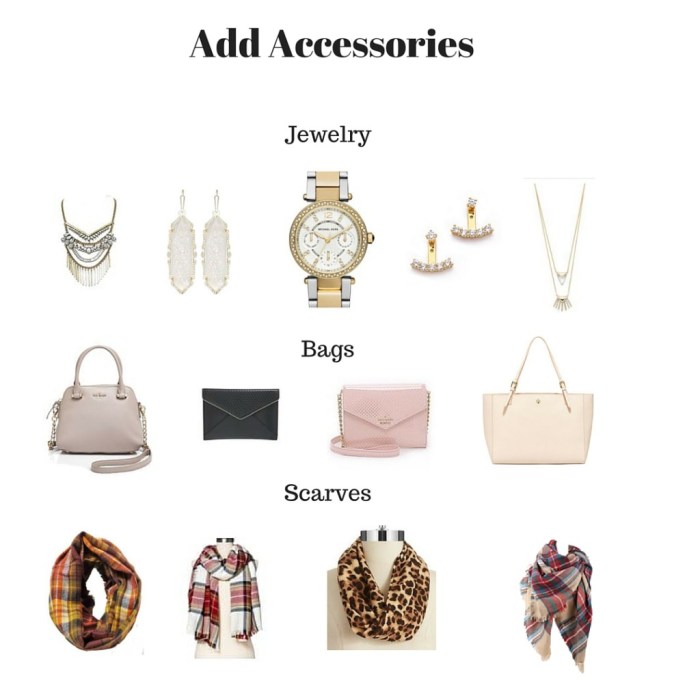Understanding Accessory Types
How to style accessories with outfits – Accessories are the finishing touches that elevate an outfit from simple to stylish. Understanding the different types and their versatility is key to effective accessorizing.
Five Common Accessory Categories
Five common accessory categories offer a wide range of styling possibilities. These categories include necklaces, bracelets, earrings, rings, and belts.
- Necklaces: From delicate pendants to bold statement pieces, necklaces add visual interest to the neckline and can draw attention to the face.
- Bracelets: These can be worn individually or stacked for a layered look, adding texture and visual weight to the wrist.
- Earrings: Earrings frame the face and can range from subtle studs to dramatic chandelier styles, impacting the overall aesthetic significantly.
- Rings: Rings add a touch of personality to the hands and can be worn on different fingers to create various effects.
- Belts: Belts cinch the waist, defining the silhouette and adding structure to an outfit. They can be decorative or purely functional.
Versatility of Accessory Categories
Each accessory category offers remarkable versatility. For instance, a simple pendant necklace can be dressed up with a formal gown or paired with a casual t-shirt and jeans. Similarly, a delicate bracelet can complement a sophisticated outfit or add a touch of elegance to a more relaxed ensemble. Statement earrings can instantly elevate a simple outfit, while subtle studs can add a touch of understated sophistication.
Statement Pieces vs. Subtle Accessories
Statement pieces, such as a large, bold necklace or brightly colored scarf, make a strong visual impact and immediately draw attention. Subtle accessories, on the other hand, offer a more understated approach, adding texture and interest without overwhelming the outfit. The choice depends on the desired level of attention and the overall style of the outfit.
Matching Accessories to Outfit Styles
Successfully matching accessories to outfit styles involves considering color coordination, visual balance, and the overall aesthetic you want to achieve.
Outfit Styling Examples
Three distinct outfit styles demonstrate the versatility of accessorizing.
- Casual: A simple white t-shirt, dark wash jeans, and white sneakers. Accessories could include a layered gold necklace, a delicate bracelet, and a crossbody bag.
- Formal: A black cocktail dress, high heels, and a clutch. Accessories might include elegant diamond earrings, a simple bracelet, and a statement ring.
- Bohemian: A flowy maxi dress, sandals, and a wide-brimmed hat. Accessories could include layered necklaces with different textures, stacked bracelets, and earthy-toned earrings.
Color Coordination in Accessory Selection
Color coordination is crucial. Accessories can either complement the outfit’s colors or introduce a contrasting element. A monochromatic look (using varying shades of one color) can be sophisticated, while using complementary colors (colors opposite each other on the color wheel) can create a vibrant and eye-catching effect.
Creating Visual Balance with Accessories
Visual balance is achieved by distributing visual weight evenly throughout the outfit. A large statement necklace might balance out a simple top, while a wide belt can draw attention to the waist and create a more balanced silhouette.
Accessorizing Based on Body Type and Occasion
Choosing accessories that flatter your body type and are appropriate for the occasion enhances your overall appearance and confidence.
Flattering Accessories for Different Body Shapes
Accessories can be used to accentuate positive features and minimize perceived flaws. For instance, a V-neck necklace can elongate the neck, while a wide belt can define the waistline. Experimentation and self-awareness are key.
Accessory Choices for Various Occasions
| Outfit Type | Occasion | Suitable Accessories | Additional Notes |
|---|---|---|---|
| Cocktail Dress | Wedding | Statement earrings, delicate necklace, clutch | Consider the wedding’s formality. |
| Pantsuit | Job Interview | Simple watch, understated necklace, minimal earrings | Professional and polished accessories are key. |
| Little Black Dress | Night Out | Bold earrings, statement necklace, high heels | Choose accessories that match the vibe of the event. |
| Jeans and Blouse | Casual Lunch | Scarf, simple necklace, watch | Keep it relaxed yet stylish. |
Impact of Accessories on Mood and Impression, How to style accessories with outfits
Accessories can significantly influence the mood and impression you create. Bold, bright accessories convey energy and confidence, while softer, more muted accessories project a sense of calm and sophistication. The careful selection of accessories allows for precise control over the message you wish to communicate.
Layering and Combining Accessories: How To Style Accessories With Outfits
Layering and combining accessories adds depth and visual interest to an outfit. It’s an art that involves understanding texture, material, and proportion.
Layering Necklaces
Layering necklaces of varying lengths and styles creates a visually appealing effect. A longer necklace can be paired with a shorter, more delicate one, or several necklaces of similar lengths can be layered together for a more cohesive look. Consider the different textures and metals to add visual interest.
Combining Textures and Materials
Combining different textures and materials adds depth and visual interest. Leather, metal, wood, and fabric can be mixed and matched to create unique combinations. For example, a leather bracelet can be paired with a beaded bracelet and a metal watch for a layered look that incorporates diverse textures.
Building a Layered Bracelet Stack
- Start with a base bracelet – a watch or a simple chain bracelet.
- Add bracelets of varying widths and textures.
- Incorporate different materials such as leather, metal, and beads.
- Ensure the bracelets are not too tight or too loose on your wrist.
- Consider the overall color scheme and ensure the bracelets complement each other.
Accessorizing for Specific Garment Types

Different garment types require different approaches to accessorizing to maximize their potential.
Accessorizing Dresses
A maxi dress might be accessorized with a simple necklace and sandals, while a little black dress could be dressed up with statement jewelry and heels. A jumpsuit can be accessorized with a belt to define the waist and a statement necklace to draw attention to the neckline.
Accessorizing Tops
A simple t-shirt can be elevated with a statement necklace or scarf. A blouse can be accessorized with a brooch or a delicate necklace. A sweater can be paired with a statement scarf or a chunky necklace.
Accessorizing Pants and Skirts
Jeans can be accessorized with a belt, a statement necklace, and a scarf. Trousers can be accessorized with a belt, a simple necklace, and a watch. A skirt can be accessorized with a belt, a statement necklace, and earrings.
Visual Representation of Accessory Styling

Visual descriptions can effectively convey the impact of various accessory combinations and placements.
Outfit Descriptions with Accessory Details
- Outfit 1: A flowy, floral midi dress in shades of coral and orange. Accessories include a woven leather belt in a contrasting brown, large hoop earrings in a bronze tone, and layered necklaces featuring turquoise and gold beads. The overall effect is bohemian chic.
- Outfit 2: A crisp white button-down shirt tucked into tailored black trousers. Accessories include a thin black leather belt, a simple silver watch, and delicate stud earrings. This creates a sleek, minimalist look.
- Outfit 3: A fitted black turtleneck sweater paired with dark wash skinny jeans and ankle boots. Accessories include a chunky knit scarf in shades of gray and cream, a layered necklace featuring a pendant and several chains, and a statement ring with a large gemstone. The style is modern and sophisticated.
Impact of Accessory Placement
A belt worn high on the waist creates a longer leg line, while a belt worn low on the hips creates a more relaxed silhouette. A necklace worn close to the neck draws attention to the face and neckline, while a longer necklace adds length and elegance. A scarf tied loosely around the neck adds a touch of casual chic, while a scarf tied as a headband creates a more polished look.
Final Review
Mastering the art of accessorizing is a journey of self-expression and style refinement. By understanding the principles of color coordination, visual balance, and the versatility of different accessory types, you can transform any outfit from simple to stunning. Remember that the key lies in thoughtful selection and strategic placement, allowing your accessories to enhance your personal style and create a cohesive, polished look. Embrace experimentation, discover your signature style, and confidently express yourself through the power of accessories.
